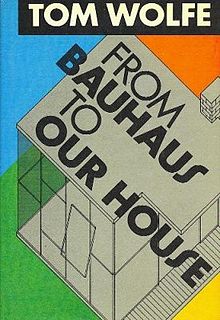New York: Farrar, Straus & Giroux, 1981.
Summary from Publisher:
As Tom Wolfe writes in his introduction to From Bauhaus to Our House,”O Beautiful, for spacious skies, for amber waves of grain, has there ever been another place on earth where so many people of wealth and power have paid for and put up with so much architecture they detested as within thy blessed borders today? . . . Every child goes to school in a building that looks like a duplicating-machine replacement-parts wholesale distribution warehouse . . . Every new $900,000 summer house in the north woods of Michigan or on the shore of Long Island has so many pipe railings, ramps, hob-tread metal spiral stairways, sheets of industrial plate glass, banks of tungsten-halogen lamps, and white cylindrical shapes, it looks like an insecticide refinery.” And every building more than ten stories high is “a glass box.” Even the architects themselves now use the term with a snigger.
The contradiction between this bare, spare, impersonal, and highly abstract architecture and the civilization it serves provides the setting of From Bauhaus to Our House. This has been the American century–just as the seventeenth century was the British century–the epoch in which a young giant achieves tremendous military and economic power and flexes its muscles, bursting with energy and exuberance and wallowing, in excess. And what architecture does America have to show for it? An architecture whose tenets prohibit every manifestation of exuberance, power, or even high spirits, as the height of bad taste.
Once again Wolfe shows how social and intellectual fashions have determined aesthetic form in our time and how willingly the creators have abandoned personal vision and originality in order to work à la mode.
Online:
TomWolfe.com (excerpt)
Amazon

